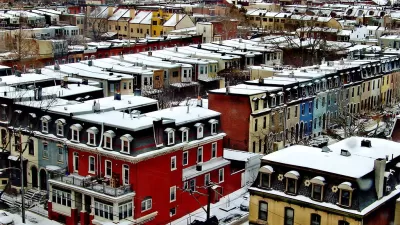To protect the character of city blocks, a Philadelphia councilwoman has proposed new restrictions on building heights on blocks with uniformly two-story buildings.
Philadelphia is dealing with market pressures to build above the “uniform cornice lines” created by the city’s many blocks of two-story buildings, according to an article by Jared Brey. The problem is that the current zoning code allows exceptions: “If you’re building on a lot surrounded on either side by two-story structures, you can still build up to the citywide residential height limit of 38 feet, but everything above the second story has to be set back at least eight feet.”
Now Jannie Blackwell, a city councilwoman, has announced that she will introduce new restrictions in the zoning code; “If you’re building on a lot surrounded on either side by two-story structures, under Blackwell’s proposed amendment to the zoning code, you couldn’t build above the taller of the two structures.”
Brey’s article has more on what the zoning code change would mean for new construction, as well as evidence of the undesirable effects of the current code.
FULL STORY: Councilwoman wants to limit building height on two-story blocks

Planetizen Federal Action Tracker
A weekly monitor of how Trump’s orders and actions are impacting planners and planning in America.

Restaurant Patios Were a Pandemic Win — Why Were They so Hard to Keep?
Social distancing requirements and changes in travel patterns prompted cities to pilot new uses for street and sidewalk space. Then it got complicated.

Map: Where Senate Republicans Want to Sell Your Public Lands
For public land advocates, the Senate Republicans’ proposal to sell millions of acres of public land in the West is “the biggest fight of their careers.”

Orange County, Florida Adopts Largest US “Sprawl Repair” Code
The ‘Orange Code’ seeks to rectify decades of sprawl-inducing, car-oriented development.

Maui's Vacation Rental Debate Turns Ugly
Verbal attacks, misinformation campaigns and fistfights plague a high-stakes debate to convert thousands of vacation rentals into long-term housing.

San Francisco Suspends Traffic Calming Amidst Record Deaths
Citing “a challenging fiscal landscape,” the city will cease the program on the heels of 42 traffic deaths, including 24 pedestrians.
Urban Design for Planners 1: Software Tools
This six-course series explores essential urban design concepts using open source software and equips planners with the tools they need to participate fully in the urban design process.
Planning for Universal Design
Learn the tools for implementing Universal Design in planning regulations.
Heyer Gruel & Associates PA
JM Goldson LLC
Custer County Colorado
City of Camden Redevelopment Agency
City of Astoria
Transportation Research & Education Center (TREC) at Portland State University
Camden Redevelopment Agency
City of Claremont
Municipality of Princeton (NJ)





























